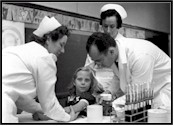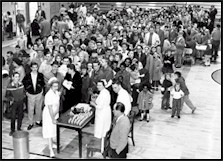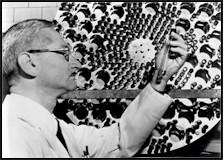Introduction: Searching for a Golden Age
Welcome to the Golden Age of American medicine. This website was
developed to encourage the exploration of American health history during
the middle years of the 20th century, the 1930s, 1940s and 1950s. During
these years the experience and the practice of medicine changed dramatically
in the United States, as did the structure of the health care delivery
system. Our goal is to arouse your curiosity about some of these changes,
so that you will be motivated to investigate how and why they took place.
 The
materials selected for inclusion reflect only a small portion of the resources
available for studying this era of American health and medical history.
Chosen for their ability to evoke important aspects of a past time, the
wide variety of images, documents, tables and graphs presented here require
close scrutiny. The questions and writing exercises that accompany this
material were designed to aid you in this process. Navigating these web
units is an experience that is part guided tour and part do-it-yourself
project. The
materials selected for inclusion reflect only a small portion of the resources
available for studying this era of American health and medical history.
Chosen for their ability to evoke important aspects of a past time, the
wide variety of images, documents, tables and graphs presented here require
close scrutiny. The questions and writing exercises that accompany this
material were designed to aid you in this process. Navigating these web
units is an experience that is part guided tour and part do-it-yourself
project.
WHY A GOLDEN AGE?
The middle of the 20th century has often been described as a golden age
of scientific advancement and miraculous medical breakthroughs, as well
as an era in which the medical profession and the institutions it controlled
enjoyed especially high public regard. Observers as varied as science
writer and journalist Paul de Kruif, AMA spokesperson Morris Fishbein,
film maker Hal Wallis, medical sociologist Eliot Freidson, and historian
John Burnham have been intrigued by this golden era. They and the scores
of others who have written about and analyzed the different aspects of
American health culture during this era did not always agree on the exact
parameters of this age of miracles. Some would have it begin as early
as the bacteriological revolution of the late 19th century. Others look
to the flowering of scientific research and pharmaceutical development
that is associated with World War I, and still others point to the changes
in medical education and public health often associated with the Progressive
era. Similarly, there is a lack of agreement about a suitable end point
for the Golden Age, although there is a fairly widespread consensus that
it is over by the late 1960s and early 1970s. The passage of Medicare
& Medicaid legislation over the strenuous opposition of the medical
profession, as well as the changing nature of the medical market place
and the increasing chorus of scholarly, journalistic, and consumer-oriented
critiques of the medicine signal the end of an era for most observers.
Taking these variations into account, we have focused our attention on
the 3 decades at the core of most accounts of the golden age: the 1930s,
the 1940s and the 1950s.

Differences over the exact chronological parameters of the golden age
resonate with the wide variation this era’s observers give to the
question: what made it a golden age? The varying answers to this question
depend substantially on the kind of evidence the observer favored. The
more demographically inclined point to the declining mortality rate for
infectious disease or to the increase in the average American’s life
span. Others more concerned with the issue of the medical practitioner’s
high social status point to the consistently high ratings that physicians
and scientists received from their fellow citizens in opinion polls. Or
they emphasize the popular culture image of doctors, nurses and medical
scientists found in novels and movies which often cast them in a heroic
light. More economically minded analysts of the golden age have pointed
to the slow but steady rise in physicians’ incomes and the expanding
role of costly hospital care as evidence for their arguments. Another
set of criteria used to judge this a golden age are accounts of this era’s
medical wonders – sulfa, blood typing, the polio vaccine, penicillin,
etc. For interested mid-twentieth century observers, there was no lack
of evidence to support a characterization of their time as one of medical
triumph and advancement in American health.
 For
many this was an era in which no problem seemed unsolvable. There were
no diseases that science could not ultimately defeat, no surgical procedure
or medical product that could not be mastered, and no technology that
could not be harnessed. And yet, this was the period in American health
history rocked by some dramatic medical scandals, such as the 1937 sulfanilamide
poisoning, which cost the lives of nearly a hundred citizens. This was
also an era in which hospitals and the latest technology remained clustered
in the larger urban areas, while many of the poorer and more rural parts
of the country were facing shortages in medical basics, including doctors
and nurses. During the same years, cancer, heart disease and a host of
other chronic health conditions remained significant problems for the
American health care system with its hospital based, acute care orientation.
Rising costs of many kinds of medical care and the economic disruptions
of a devastating economic depression and a world war further complicated
the health lives of many Americans. How could the years of the Great Depression
and the Second World War be part of a golden age in American health history?? For
many this was an era in which no problem seemed unsolvable. There were
no diseases that science could not ultimately defeat, no surgical procedure
or medical product that could not be mastered, and no technology that
could not be harnessed. And yet, this was the period in American health
history rocked by some dramatic medical scandals, such as the 1937 sulfanilamide
poisoning, which cost the lives of nearly a hundred citizens. This was
also an era in which hospitals and the latest technology remained clustered
in the larger urban areas, while many of the poorer and more rural parts
of the country were facing shortages in medical basics, including doctors
and nurses. During the same years, cancer, heart disease and a host of
other chronic health conditions remained significant problems for the
American health care system with its hospital based, acute care orientation.
Rising costs of many kinds of medical care and the economic disruptions
of a devastating economic depression and a world war further complicated
the health lives of many Americans. How could the years of the Great Depression
and the Second World War be part of a golden age in American health history??
In the following sections of our website you will find materials that
will help you explore these questions and other aspects of American health
culture in the 1930s,1940s and 1950s. Please feel free to indulge your
own curiosity, but be aware that we have focused our attention on the
following questions:
What makes these years a golden age of medicine?What is the nature
of the evidence for and against this proposition?
Who thought of it as a golden age? Did doctors? (Which ones -- general
practitioners? Specialists? Surgeons? ) Did public health officials?
Did the AMA? Did pharmaceutical companies? Did nurses? Did patients?
Did journalists? Why did these various groups hold the opinions they
did? Does it matter that they see this era differently?
Who is responsible for health in the golden age? Is it the individual?
The medical profession? The government?
What is the status of the medical profession during this era? Does their
status have anything to do with the characterization of this period
as a golden age?
What is the nature of medical authority in this era? How important is science
to this authority? What claims does scientific medicine make on the American
imagination and economy in this era? How important is science to the golden
age?
What was the health experience of the average American? Who did they consult
when they had health related questions? What was the nature of the doctor-patient
relationship?
What role did government – local, state and federal -- play in the
health lives of Americans in this golden era?
|

